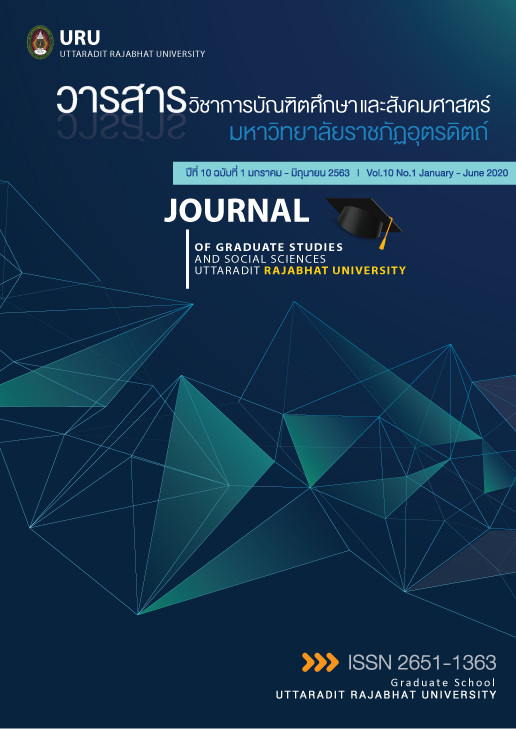Influence of operation resource efficiency on unnecessary production processes of Small and Medium Enterprises (SME)
Keywords:
Efficiency, Operation resource, Unnecessary production processes wasteAbstract
This research studied the method efficiency, management efficiency, material efficiency and man efficiency which influenced the unnecessary production processes waste of SMEs entrepreneurs. The population was SMEs entrepreneurs who registered the Micro SME project with OSMEP for reorganization. The research used 300 questionnaires to collect data. The researcher collected data with purposive sampling. Statistical analysis used descriptive statistics analysis, one-way ANOVA and multiple regressions in stepwise method. The research results showed that (1) all 5 variables were method efficiency, management efficiency, material efficiency, man efficiency, and unnecessary production processes waste had a high level of average values, (2) Different types of entrepreneur had not different in operation resources efficiency and unnecessary production processes waste, and (3) The operation resources were X1 = method efficiency, X2 = management efficiency, X3 = material efficiency, and X4 = man efficiency had direct affect to Y = unnecessary production processes waste. It explained by the equation Y = -0.687 + 0.516X1 + 0.521X2 + 0.274X3 - 0.098X4. This equation was able to explain 72.8% significantly. This research suggests that SMEs entrepreneurs who want to reorganize their firms should emphasize and reduce unnecessary production processes waste by use the method, management, material efficiency, and man for maximum efficiencies.
References
คุลยา ศรีโยม และพิเชษฐ์ จันทวี. (2561). การลดความสูญเปล่าในกระบวนการผลิตดอกไม้จันทน์ กรณีศึกษา กลุ่มออมทรัพย์เพื่อการผลิตบ้านแหลมเคียน. การประชุมหาดใหญ่วิชาการระดับชาติและนานาชาติ ครั้งที่ 9.
จักรกฤษณ์ ฮั่นยะลา. (2557). การพัฒนาประสิทธิภาพกระบวนการผลิตกางเกงเวสในโรงงานอุตสาหกรรมเสื้อผ้าสาเร็จรูป กรณีศึกษาบริษัท นอร์ธเทิร์น แอทไทร์จำกัด. วารสารวิชาการคณะเทคโนโลยีอุตสาหกรรม มหาวิทยาลัยราชภัฏลำปาง, ปีที่ 7, ฉบับที่ 1 มกราคม 2557 – มิถุนายน 2557.
ไพศาล ลาภสมบูรณ์ชัย และณัฏฐพันธ์ เขจรนันทน์ (2015). การลดความสูญเปล่าในกระบวนการบรรจุหอมหัวใหญ่ โดยเทคนิคการผลิตแบบโตโยต้า: ศึกษาโรงงานถาวรการเกษตร. สุทธิปริทัศน์, ปีที่ 29 ฉบับที่ 92 ตุลาคม - ธันวาคม 2558.
วรัญญา ภัทรสุข. (2536). เศรษฐศาสตร์การเปลี่ยนแปลงทางเทคโนโลยี. กรุงเทพฯ : คณะเศรษฐศาสตร์จุฬาลงกรณ์มหาวิทยาลัย.
สำนักงานส่งเสริมวิสาหกิจขนาดกลาง และขนาดย่อม. (มปป). รายงานสถานการณ์ SME รายเดือนกรกฎาคม 2561 (ออนไลน์). สืบค้น 23 กันยายน 2561, จาก http://www.sme.go.th.
สุชาดี ธำรงสุข, วันชัย แหลมหลักสกุล และสมนึก วิสุทธิแพทย์. (2559). การลดความสูญเปล่าในกระบวนการผลิตของโรงงานผลิตเครื่องปรับอากาศ. วารสารวิชาการพระจอมเกล้าพระนครเหนือ, ปีที่ 26 ฉบับที่ 3 ก.ย.–ธ.ค. 2559.
สุภาภรณ์ สุวรรณรังษี และเดชา พวงดาวเรือง. (2555). การลดความสูญเปล่าของกระบวนการผลิตข้าวกล้องงอกกรณีศึกษา กลุ่มเกษตรกรบ้านจาปา จังหวัดสกลนคร. การประชุมวิชาการข่ายงานวิศวกรรมอุตสาหการ ประจำปี พ.ศ. 2555, 17-19 ตุลาคม 2555 ชะอำ เพชรบุรี.
Chiarini, A. (2014). Sustainable manufacturing-greening processes using specific Lean Production tools: an empirical observation from European motorcycle component manufacturers. Journal of Cleaner Production, 85 (2014), pp. 226-233.
Chomatowska, B., & Dobiesz, A. Z. (2014). Elimination of wastes in production enterprises-case studies. Research in Logistics & Production.
Fercoq, A., Lamouri, S., & Carbone, V. (2016). Lean/Green integration focused on waste reduction techniques. Journal of Cleaner Production, 137 (2016), pp. 567-578.
Geffen, C. A., & Rothenberg, S. (2000). Suppliers and Environmental Innovation: The Automotive Paint Process. International Journal of Operations and Production Management, Volume 20, No. 20, 2000. pp. 166-186
Grzelczak, A., & Lewandowska, K. (2016). Eliminating Muda (Waste) in Lean Management by Working Time Standardization. Arabian Journal of Business and Management Review.
Kholil, M., Hendri, Hanum, B., & Setiawan, R. (2018). Using 7 Waste Approach and VSM Method to Improve the Efficiency of Mackerel Fish Crackers Production Time at Small Medium Enterprise (SME). International Journal of Industrial Engineering and Operations Management (IJIEOM).
Payaro, A., & Papa, A. R. (2016). Wastes and Tools in the Lean Marketing Strategy: An Exploratory Study in the Italian SMEs. Journal of Business and Economics.
Rawabdeh, I. A. (2005). A model for the assessment of waste in job shop environments. International Journal of Operations & Production Management, Vol. 25 No. 8, 2005, pp. 800-822.
Sternberg, H., Stefansson, G., Westernberg, E., Gennas, R. B. A., Allenstrom, E., Nauska, M. L. (2012). Applying a lean approach toidentify waste in motorcarrier operations. International Journal of Productivity and Performance Management, Vol. 62 No. 1, 2013, pp. 47-65.
Published
How to Cite
Issue
Section
License
แนวคิดและทัศนะในบทความเป็นความรับผิดชอบของผู้เขียนบทความ การนำบทความหรือส่วนหนึ่งของบทความไปตีพิมพ์เผยแพร่ ให้อ้างอิงแสดงที่มา และข้อมูลเกี่ยวกับผู้เขียนบทความ



